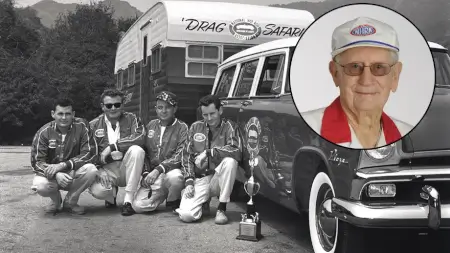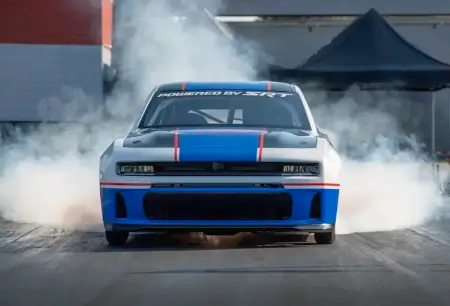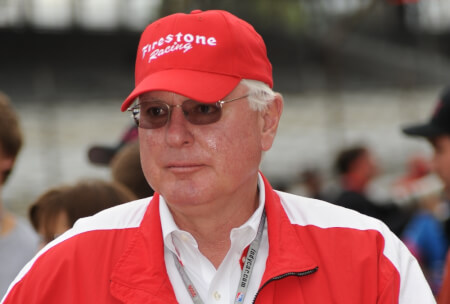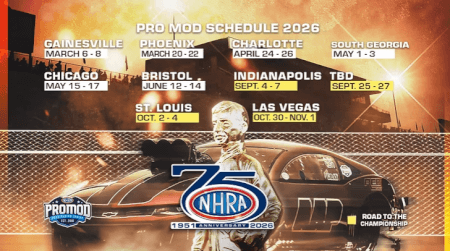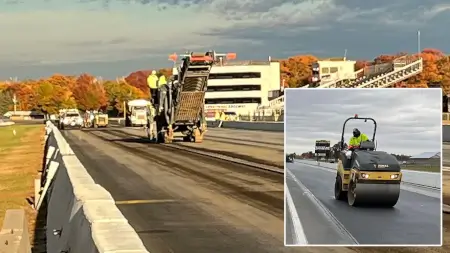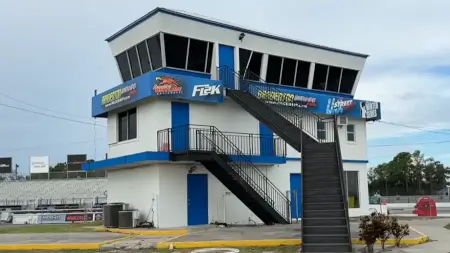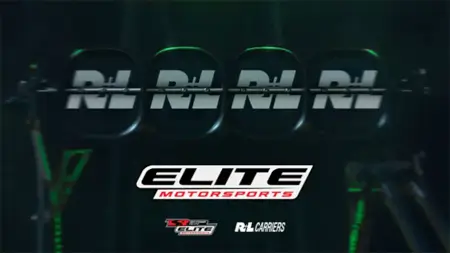August 21st 2025
Chic Cannon, last surviving member of original NHRA Drag Safari, passes away
Chic Cannon, the last surviving member of the original NHRA Drag Safari that traversed the nation in the mid-1950s to spread the NHRA gospel, passed away Aug. 20. He was 96.
Cannon, along with Bud Coons, Bud Evans, and photographer Eric Rickman, were the consistent members of the Safari, which from 1954-56 showed early hot rodders how to stage events from safety inspection through trophy presentations. They traveled around the United States in a Dodge station wagon towing a trailer full of equipment, where car clubs eagerly awaited their arrival at each stop.
Coons died in June 2015 at the age of 90, a year after Evans passed at age 86. Rickman died in January 2009 at age 90.
Led by Coons, a former sergeant in the Pomona Police Department handpicked by NHRA founder Wally Parks as the field director, the Safari team packed into a station wagon hitched to a trailer that carried everything needed to set up a mobile event: early timing equipment, a PA system, field telephones, a one-cylinder generator, and miles of stainless-steel wire to bring all the electronic equipment to life.
Cannon, who had a background in engineering and car building, ran tech. Rickman was along to chronicle the action to be published in Hot Rod magazine, where Parks was still the editor. Evans, a lakes racer and announcer at the dragstrip in Colton, Calif., was the announcer. Evans often joined Cannon at the pre-race tech inspection and created a large file of index cards with information on each car — the engine and drivetrain specs, where it was based, and how fast it had gone — to aid his announcing.
Typically, the Safari would arrive in a town on a Wednesday or Thursday and begin meeting with the local clubs or racetrack operators. The Safari members would meet with local law enforcement and civic officials, and Coons would sometimes do radio or television interviews to promote the upcoming weekend’s event. With the help of the car clubs, they would set up the racetrack, sometimes even erecting a temporary timing and announcing tower.
Typically, the Safari would arrive in a town on a Wednesday or Thursday and begin meeting with the local clubs or racetrack operators. The Safari members would meet with local law enforcement and civic officials, and Coons would sometimes do radio or television interviews to promote the upcoming weekend’s event. With the help of the car clubs, they would set up the racetrack, sometimes even erecting a temporary timing and announcing tower.
“We just had a great time together those years, and we couldn’t have asked for a better or more confident leader than Bud,” Cannon once said. “We almost always got a good reception, but it wasn’t always an easy job – a lot of people didn’t like either Bud or me from time to time because of the rules we were helping put into place – but it’s just unreal what the sport became from those first days.”
The first Safari expedition in 1954 left California June 10, headed east to Caddo Mills, Texas, for the first meet, June 19-20, then on to Mansfield, La.; Edna, Kan.; Scribner, Neb.; Linden, N.J.; Pennellville, N.Y.; Akron, Ohio; Detroit; Pocatello, Idaho; Ogden, Utah; and Salt Lake City before concluding at the Bonneville speed trials event, tying the sport’s past with its future.
In 1955, the Drag Safari embarked on its second nationwide crusade, an 18-week, 20,000-mile tour, helping sanctioned strips present 18 official Regional Championships in California, Oregon, Washington, Idaho, Colorado, Iowa, Missouri, Indiana, Ohio, Massachusetts, New York, Pennsylvania, North Carolina, Florida, Tennessee, and Texas. It was during this tour that many newspapers began to refer to the Drag Safari as the NHRA "Safety Safari." The Safari's final stop was Great Bend, Kan., where NHRA staged its first National Championship Drags, Sept. 29-Oct. 2, on the 8,000-foot runway of the Great Bend Municipal Airport.
In 1955, the Drag Safari embarked on its second nationwide crusade, an 18-week, 20,000-mile tour, helping sanctioned strips present 18 official Regional Championships in California, Oregon, Washington, Idaho, Colorado, Iowa, Missouri, Indiana, Ohio, Massachusetts, New York, Pennsylvania, North Carolina, Florida, Tennessee, and Texas. It was during this tour that many newspapers began to refer to the Drag Safari as the NHRA "Safety Safari." The Safari's final stop was Great Bend, Kan., where NHRA staged its first National Championship Drags, Sept. 29-Oct. 2, on the 8,000-foot runway of the Great Bend Municipal Airport.
The NHRA Drag Safari kicked off its third and final tour of the country in 1956. Plymouth supplied two new cars for the Safari, a '56 Fury and a '56 Suburban wagon, both painted red, white, and blue, and the team staged 18 Regional Championships events in California, Colorado, Texas, New Jersey, Illinois, Iowa, Utah, and Oregon, with many more of today's well-recognized names taking part, including Bernie Partridge, who won the "C" Stock class at the West Coast Regional Championships at San Gabriel Valley Dragstrip and later would join NHRA and play a major role in its continued development.
In 1955, the Drag Safari embarked on its second nationwide crusade, an 18-week, 20,000-mile tour, helping sanctioned strips present 18 official Regional Championships in California, Oregon, Washington, Idaho, Colorado, Iowa, Missouri, Indiana, Ohio, Massachusetts, New York, Pennsylvania, North Carolina, Florida, Tennessee, and Texas. It was during this tour that many newspapers began to refer to the Drag Safari as the NHRA "Safety Safari." The Safari's final stop was Great Bend, Kan., where NHRA staged its first National Championship Drags, Sept. 29-Oct. 2, on the 8,000-foot runway of the Great Bend Municipal Airport.
In 1955, the Drag Safari embarked on its second nationwide crusade, an 18-week, 20,000-mile tour, helping sanctioned strips present 18 official Regional Championships in California, Oregon, Washington, Idaho, Colorado, Iowa, Missouri, Indiana, Ohio, Massachusetts, New York, Pennsylvania, North Carolina, Florida, Tennessee, and Texas. It was during this tour that many newspapers began to refer to the Drag Safari as the NHRA "Safety Safari." The Safari's final stop was Great Bend, Kan., where NHRA staged its first National Championship Drags, Sept. 29-Oct. 2, on the 8,000-foot runway of the Great Bend Municipal Airport.
The NHRA Drag Safari kicked off its third and final tour of the country in 1956. Plymouth supplied two new cars for the Safari, a '56 Fury and a '56 Suburban wagon, both painted red, white, and blue, and the team staged 18 Regional Championships events in California, Colorado, Texas, New Jersey, Illinois, Iowa, Utah, and Oregon, with many more of today's well-recognized names taking part, including Bernie Partridge, who won the "C" Stock class at the West Coast Regional Championships at San Gabriel Valley Dragstrip and later would join NHRA and play a major role in its continued development.
Even though the Safari was parked, its three-year effort had done the job. By early 1957, NHRA's sanctioned-track listing included more than 100 venues in 38 of the 48 states, and the Safari team, its work done, was disbanded. However, NHRA continued to send as many as 500 "How to Form a Club" kits each month, and its growing cadre of regional advisors helped keep everyone in line and informed. An early 1957 survey by a leading safety organization to the nation's police departments, asking for each department's evaluation of organized hot rod activities, received 300 replies; 73% were favorable, 23% were noncommittal, and just 4% were against hot rodding.
Even though the Safari was parked, its three-year effort had done the job. By early 1957, NHRA's sanctioned-track listing included more than 100 venues in 38 of the 48 states, and the Safari team, its work done, was disbanded. However, NHRA continued to send as many as 500 "How to Form a Club" kits each month, and its growing cadre of regional advisors helped keep everyone in line and informed. An early 1957 survey by a leading safety organization to the nation's police departments, asking for each department's evaluation of organized hot rod activities, received 300 replies; 73% were favorable, 23% were noncommittal, and just 4% were against hot rodding.
“NHRA owes an eternal debt of gratitude to people like Chic Cannon who were on the front lines for the NHRA in its earliest years,” said NHRA President Glen Cromwell. “The contributions that Chic and the entire Safari crew made to the growth of the NHRA cannot be underestimated. Under the guidance of Wally Parks, they set out to showcase our sport and help legitimize and grow the sport of hot rodding and helped establish roots in the racing community that still exist today.”
For more Industry News, please Click Here
